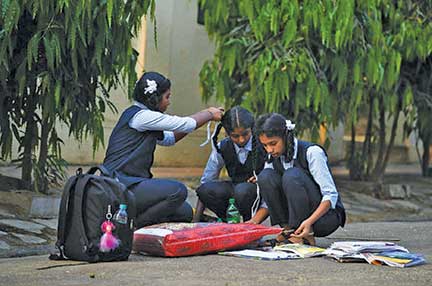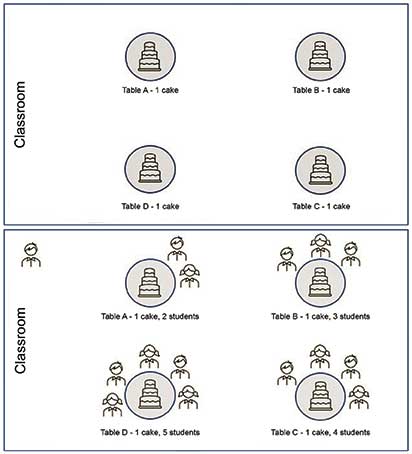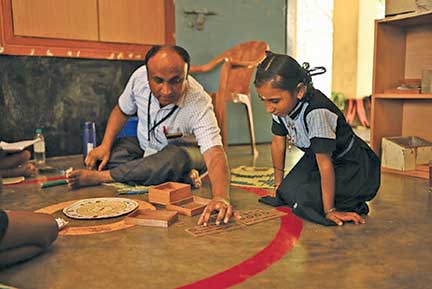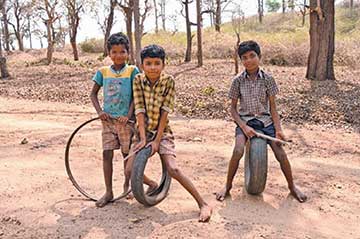Praveen Kumar S
A few years ago, we had arranged a teacher capacity-building program for mathematics teachers of lower primary schools. The program focused on enabling the teachers to conduct activity-based sessions related to abstract mathematical concepts for students in rural and tribal areas around Saragur, Mysuru district. One of those activities was built around the concept of fractions.

You may agree that it is easy to compare fractions if the denominator is the same but the numerator different. If a circle is divided into a fixed number of parts, the denominator of the fraction is fixed. The larger the region that we shade, the greater the numerator. So the fraction with the greater numerator is bigger. Seems pretty straightforward!
Now imagine a slightly different scenario. In a class with 15 students, there are four tables with a cake on each table.
While one of the students is waiting outside, the remaining students are randomly distributed to occupy the seats at the tables such that each of the tables has a different number of students.
Now, the student who is waiting outside is called into the classroom and asked to choose a table where he/she will get the maximum share of the cake. The students intuitively discover that they get the maximum share when there is the least number of students at the table, thereby understanding the concept of comparison of fractions.

During the workshop, we conducted the above activity with the participating teachers and it was a success. The teachers went back and tried the activity in their schools. Most of the feedback was very encouraging.
The following week, I received a distress call from Shashidhar, a teacher at the Viveka Tribal Centre for Learning (a unit of Swami Vivekananda Youth Movement, SVYM*). He was angry that the activity was useless! The next day I went to the school and observed the class while Shashidhar went about the same activity following the protocol. Everything seemed to happen as expected until the child chose the table with the maximum number of students.

For a better understanding, we sent the child out and redistributed the students just to ensure randomization. The child walked into the class and once again chose the table with the maximum number of students (a different set of students from the earlier case). This was intriguing!
Unable to understand the student’s logic, I called him aside and asked him why he chose that table. The child naively responded that Shashidhar sir asked him to choose the table that would give him the most happiness. He chose the table with the most classmates because more friends to share meant more happiness for him.
Shashidhar deviated from the protocol by framing the task as choosing the table that gives maximum happiness (instead of choosing the table that gives the maximum share of the cake).
This child demonstrated a great social value of the indigenous tribal community that all of us adults – resource persons and teachers – couldn’t even make sense of and judged it a mistake. It is unfortunate that while on the one hand, we are focused on conceptual clarity and become insensitive to these values of the communities, on the other, we are determined to add value education to the curriculum.

This incident raised several questions to which I am still trying to figure out the “right” answers –
- Is school education making us literate or it is making us educated?
- Isn’t the curriculum decided by someone in a position of authority?
- Does science education in the present form acknowledge the fact that we are social beings?
- Does the current curriculum lack sensitivity to community values and wisdom? How do we become sensitive to and protect community values instead of pushing SEL/happiness/value education curricula?
- How can school education evolve beyond enrollment, attendance, achieving learning outcomes, and inclusion?
- Do these children require us to educate them at all?
There are no easy answers and we may never have them. At SVYM, we are trying to build a schooling system that will be
• respectful of the community’s values and wisdom,
• a springboard for the aspirations of the local community,
• building human and social capital of the communities that we work with,
• a model to scale, contextualize and emulate in our work with indigenous communities across the country and beyond.
In this churning process, we are sure each of us will become better “teachers”.
*SVYM is a development organization engaged in building a new civil society in India through its grassroots to policy level action since 1984. SVYM’s focus areas are health, education, socio-economic empowerment, and training and research. The organization has its headquarters in Mysuru, Karnataka.
The author started his career as a science teacher and is currently the head of the education sector at SVYM. He was a member of the NEP 2020 Task Force of the Government of Karnataka. He can be reached at praveen@svym.org.in.
